Noise Problems and Legal Aspects as a Subject in Early International Congresses
By Walter Montano
Technical Department, Arquicust, Gualeguaychu, Argentina
Editor’s Note: This is the second in a series of articles documenting the history of global actions seeking to control noise. These are provided as contributions to the upcoming 50th anniversary of I-INCE for its international efforts to create the environment for important discussions on noise control at the INTER-NOISE conferences. They are also contributions to the International Year of Sound 2020–2021.
One of the goals in studying the history of science is to seek the works that inspired early authors, those works that gave them a serendipitous moment of discovery. While some historical reviews relating to acoustics are based on previous studies, this means the original context and sources of data have been lost. This article mentions only the works that have been the result of systematic investigation that, in the author’s opinion, correspond to the first mention of the problem of deafness. It covers historical acoustic facts and findings until 1914—that is, before World War I. Perhaps the reader may find some “old” words or words that currently have a different meaning or use; the author wants to make it clear that these terms were those used at the time of writing and are copied to respect the original writings.
In the NNI issue for December 2020, it was noted that there had been an attempt to hold an international congress of anti-noise groups in 1912, in New York City (Montano 2020). Although this particular congress was not held, there was an International Congress of Otology held in Boston City in August of 1912. This Boston meeting included discussions on the noise problem with the goal to eliminate it from the cities. An International Hygiene Congress took place in Washington, DC, in September of the same year. Although only three papers on noise were presented, is considered to be the first to include discussions on legal aspects of exposure to noise.
The most important sources of information that the author has used to write this article are the old newspaper columns or sections that commented scientific advances or technological curiosities, sources that probably were never commented on in books on acoustics—for example, in a newspaper article, mention of a presentation by Wallace Sabine (see fig. 1) to the American Institute of Architects on November 2, 1898.
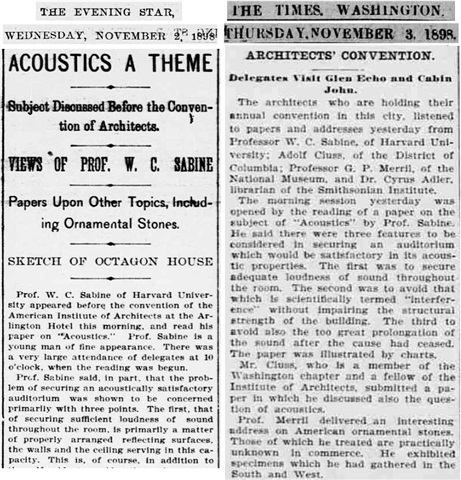
Early Studies on Deafness
“Discourse on deafness and speechlessness” (written in Latin) is the first empirical study about deafness of people, published in 1591 by Salomon Alberti (1540–1600), a renaissance German anatomist. He was involved with education of deaf people and was the first to leave behind the ancient ideas that deafness is consequence of damage to the soul. Alberti also was the first to differentiate congenital deafness from other ear injuries that produce deafness (Turkington and Sussman 1992).
A methodical observation on deafness was published in the eighteenth century by Bernardino Ramazzini, who wrote the first encyclopedia about occupational diseases. He attributed deafness to incessant noise resulting from the continuous beating of newly mined copper (Ramazzini 1713). For the next 100 years, there were no great advances in this matter, and physicians attributed hearing loss only to metal artisans and workers.
The following are the first physicians who systematically investigated hearing loss in workers and later published their results in scientific journals.
John Fosbroke,a British doctor and one of the first to theorize clinically about deafness in people, explained his medical findings in three communications that were published in The Lancet. In the first, he proposed that studies of deafness are not a separate subdivision and should be part of the general surgical treatment of the ear (Fosbroke 1831a). In the second, he proposed to study separately the hearing loss in workers (including those in the military) because their deafness is a consequence of their employment and it affected them gradually and without them being aware of it, as opposed to deafness produced by other pathology factors (Fosbroke 1831b). In the third, he analyzed the physiological predisposition for deafness a person may have (such as hereditary, pathological, age, organic disorders, etc.) (Fosbroke 1831c).
Édouard-Adolphe Duchesne (1804–1869) was a French physician who investigated hearing loss of locomotive drivers and boilermakers. He was the first to write about hearing loss in railway workers instead of metal workers. In 1857, in “Railways and Their Influence on the Health of Mechanics and Drivers,” he attributed deafness among mechanics to the noise produced by the steam of the machine when it is allowed to escape—especially the sharp and very frequent blows of the whistle, which he considered to have a marked effect on hearing (Duchesne 1857). It is interesting that after this research, physicians associated the deafness of professional railway workers with “some kind of” specific infection in the inner ear due to a combination of a high sound level and water vapor environment.
Daniel Bennett St. John Roosa (1838–1908) was an American physician and otologist, being in close contact with Clarence J. Blake, who identified that hearing loss is not the same at different tones, and he proposed using a C tuning fork[1] instead of a watch to test the impairment of hearing. Dr. Roosa realized that “some persons can hear a watch quite a number of inches from the ear, while they hear conversation very badly” (Roosa 1873). Despite being the first to propose this, Roosa’s work was scarcely mentioned in subsequent publications, until Girdner mentioned it in “Noise and Health” (Girdner 1901).
Alexandre Layet (1840–1916) was a French hygienist who hypothesized in 1875 that sheet-iron workers, coppersmiths, and blacksmiths were vulnerable to hearing loss and that the risk of hearing impairment increased the longer they remained in their respective occupations (Layet 1875).
Jacob Gottstein (1832–1895) and R. Kayser, from Breslau, Poland, wrote “On hearing loss in locksmiths and blacksmiths” (in German) in 1881, one of the first investigations to determine if the occupational activity of those who had been practicing their job for years exerted a harmful influence on the ear. To make the causal dependence of the results on the specific occupation even clearer, they examined a number of people from another lower noise occupational branch, such as bricklayers. They tested the hearing acuity of each ear after determining the subjective and objective phenomena for the whispering voice (from two to three meters). The three data tables of their research are shown in fig. 2 (Gottstein and Kayser 1881).
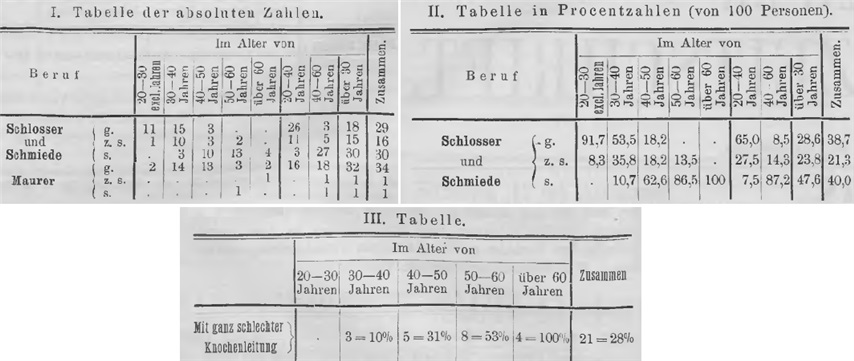
They briefly summarize the results of their investigations as follows: (1) Locksmiths and blacksmiths experience a considerable hearing loss as a result of their work, and this loss increases over the years, and (2) the hearing loss in locksmiths and blacksmiths is essentially caused by the noise surrounding them during work and is most likely due to an affection of the auditory nerve as a result of over stimulation by sound and vibration (Gottstein and Kayser 1881).
Thomas Barr (1846–1916), a Scottish doctor, published interesting research about deafness in boiler workers (Barr 1886). His findings were similar to those of Gottstein and Kayser, Roosa, or Layet. But his recommendations to prevent professional deafness are important, and he makes a detailed acoustic analysis of the effects of noise on the ear and how deafness occurs. He wanted to analyze the noise by means of phonograph recordings, but he realized that the high-pitched sound produced by the hits of the metal hammer on the steel boilers was not recorded by the tinfoil of the phonograph. As part of his work, he was exposed to the noise in the metal workers’ workplace, so his notes go beyond the subjectivity of an interview and are based on his own perception of the problem.
John Harvey Girdner (1856–1933), a well-known New York surgeon, published in the North American Review, September 1896, an article titled “The Plague of City Noises.” This is an emblematic and influential work about the effect of noise on urban health. He wrote, “I do not wish to be considered an alarmist, or hypercritical, but it seems to me the time has come when something should be done to lessen the constant and largely unnecessary outrages committed on the sense of hearing of the residents of large cities” (Girdner 1896). This publication is a form of “political pamphlet” against unnecessary din, and Girdner seriously advocated a “society for the prevention of noise.” His proposal was widely publicized in the press—for example, the Engineering Magazine (1986) published a review of that article, saying, “We have no doubt that such a society can be organized, that it could affect the needed reforms, and that it would receive the support of the medical faculty, and the approval and cooperation of the best citizens.”
The following year, Girdner published another article, continuing his ideas and emphasizing the importance of legislating to stop people who make unnecessary noise. For recommendations of noise reduction, he proposed “the removal of the steel wheels of the carriages by the rubber wheels of the cars plus the asphalting of the streets, this would eliminate the urban noise” (Girdner 1897).
In 1901, Girdner published a book titled Newyorkitis in reference to a medical disorder that affected people who lived in New York City because of the environmental conditions—and the deafness among those afflicted. At the same time, he published an article in Munster’s Magazine (1901), in which he gave a specific treatment for the deafness suffered by people living in big cities. “The boiler factory no longer has a monopoly in producing this affection. The streets or our modern cities are becoming so noisy that unless the evil is abated by improved pavements and means of traffic, the name of the disease will have to be changed to the city dweller’s deafness.”
Ninth International Otological Congress in Boston in 1912
The transactions of this congress are not freely accessible on the internet yet, but it is possible to have an idea the magnitude of this event because there are many reports in newspapers and specialized publications all around the world. The following facts were mentioned in several newspapers and so can be considered as valid.
The Ninth International Otological Congress was held in Boston on August 12–16, 1912, at Harvard Medical School. “The number of practitioners who attended was 410, of whom 25 were official representatives of foreign countries” (Schafer 1912, 599). Medical professors from such colleges and institutions as Harvard, Johns Hopkins, Columbia, Cornell, Yale, Princeton, Williams, and the University of Pennsylvania, as well as scientists and those interested in questions of public welfare had met on that occasion and discussed how best the “evil” noise may be overcome.
The New York Times, on August 5, 1912, published an article “Physicians Combine to Abolish Noise,” mentioning that Clarence Blake “will address the convention on the deleterious effects of noise upon the human ear.” In fig. 3, some headlines from different newspapers are shown.
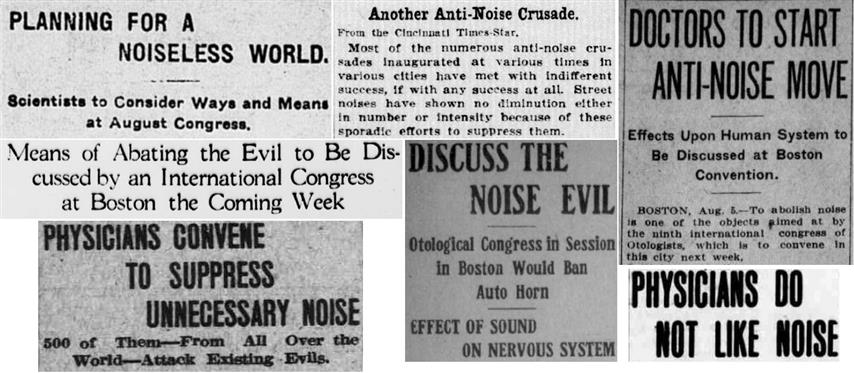
The presence of Clarence John Blake (1843–1919) as chairman of this congress is not a minor detail, as he was a close friend of Thomas A. Edison (1847–1931) and, according to a memoir about them, Blake collaborated with Edison: “This is a narrative of two men, one an otologist, the other a teacher. They had a common interest in the welfare of the deaf. They met, formed a lasting friendship, and then went on to share experiences and ideas. Before they were finished, the mind of one knew the idea of an instrument that would revolutionize communication” (Carpe Librum, n.d.).
According to many articles in different newspapers, the Society for the Suppression of Unnecessary Noises called itself the Otological Congress. The very name contains the words “unnecessary noise,” so it seems that by Julia Barnett Rice considered this congress as a part of her anti-noise group, perhaps because some of the physicians were close advisers and, during the congress, a few newspapers mentioned the importance of her work against unnecessary noise (The Sun, August 5, 1912; for more on Rice, see the December 2020 issue of NNI).
“The Suppression of Unnecessary Noise” by Dr. Morse
In “The Suppression of Unnecessary Noise,” a paper by Edward Sylvester Morse (1838–1925), he called attention to some important issues. “It is the emphatic judgment of our most distinguished names in medical science…that noise affects the nerve centers in a disastrous way, leading to neurasthenia, and even to insanity, and often marks the adverse turning point of one balanced between death and recovery.”
Dr. Morse was an authority on the subject of noise; he lived in the small town of Salem, Massachusetts, most of his life, rather than in a noisy, crowded, and disease-prone city. Even in Salem, the iconoclastic Morse crusaded against noise pollution, including that produced by factory whistles, loudly ticking clocks at night, sirens, and boat horns in the harbor. He dedicated his life to fighting against noise problems, and he wrote dozens of articles on the subject.
Dr. Friedrich Siebenmann
Dr. Friedrich Siebenmann (1852–1928), of Switzerland, presented his milestone work “Demonstration of microscopic preparations in the projection apparatus” (written in German) that showed the cochlear lesions of a degenerative character consequent to prolonged occupational exposure to loud noise and some immediate lesions following exposure to a loud sound with major force value and of sudden impact (Siebenmann 1912).
An “International Anti-noise Crusade” Proposed by Dr. Vittorio Grazzi
Dr. Vittorio Grazzi (1849–1929), of Italy, founded the Italian Society of Otology, Laryngology and Rhinology in 1892 (SIOeChCF, n.d.). As a physician, he proposed an international anti-noise crusade and the establishment of an international commission for the suppression of noise. There are few references to Grazzi in Italian, about his work on the annoyance of the city noises. Fig. 4 shows some newspapers that highlighted Grazzi’s proposal (Bemidji Daily Pioneer of Minnesota, Bismarck Daily Tribune, and Farmer of North Dakota).

The presence of this Otological Congress in the US press is remarkable, as the New York Times (August 5, 1912) highlighted Grazzi’s proposal: “The movement for the suppression of noise originated in Italy. It had its inception in protest against the excessive whistling of locomotives, and spread to a fight against all harmful noises and grew to international scope.”
The XV International Congress of Hygiene and Demography in Washington, DC, in 1912
Following the Boston Congress, the XV International Congress of Hygiene and Demography was held in Washington, DC, in September 1912, but only three articles on noise were presented.
Clarence J. Blake presented his paper “The Suppression of Unnecessary Noise,” explaining in a colloquial way the mechanism of the auditory system and how loud noise (and high-pitched sounds) affect the inner year and the brain. He put emphasis on the “objectionable effects of noise upon the human economy” and also suggested that “to discuss this subject should be upon the program of every conference upon the subject of hygiene and sanitation. It should be dealt with, in some form or other, from the human side, in every international otological congress.” Blake’s vision was to have an international effort to deal with noise problems: “It should be a permanent part of the purpose of existence of an institute of otologic research…and as bureau for the dissemination of information upon such acoustic questions” (Blake 1913).
Stoughton Bell (1874–1967), a lawyer from Massachusetts, presented “Existing Legal Provisions with Regard to the Suppression of Unnecessary Noises,” a complete summary of his work about fighting unnecessary noise. He was involved in writing several Massachusetts legislations and general principles governing the regulation of noise in the early twentieth century. It is interesting that he was aware of the perception of noise, saying, “There are no fixed limits which govern either public or private nuisances. Each case must be judged by itself. The purpose, for which the noise is made, the character of the noise, the place where it is made, and the time of making, must all be taken into consideration.” He differenced the unnecessary noises from those that are inevitable but have to be controlled (Bell 1913).
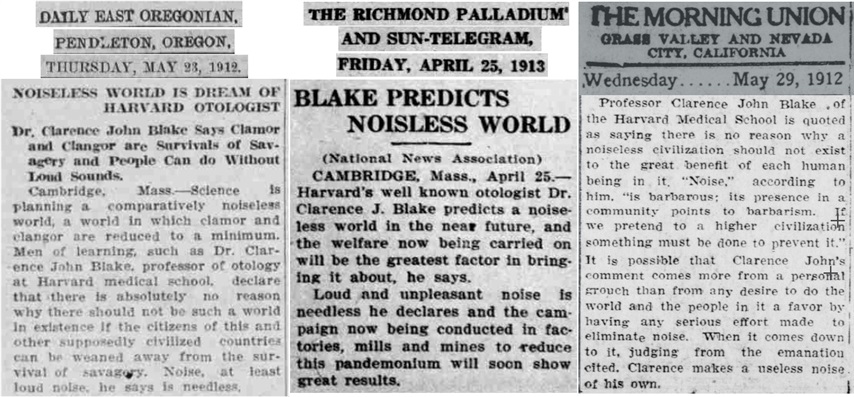
Siegmund Auerbach (1866–1923) was a German neurologist, and in his very long article “The legal fight against avoidable noise: a nerve hygienic requirement” (in German), he comments on the neurological and mental problems to which people were exposed inside their homes and workers in their jobs. These were compounded by exposure to urban noise when they move around the city. Many of his 1912 demands are still valid in 2021: “Building companies or similar interested parties should try to build blocks of houses where music and singing are generally not allowed. I would like to think that such an enterprise would succeed” (Auerbach 1913). The New York Times interviewed him after this congress and published on October 27, 1912, his opinions about the relationship between noise and neurasthenia. Auerbach was one of the first to link urban noise with neurasthenia and that it was important to prevent it because of its effect on human health.
Technology at the Beginning of the Twentieth Century
Having read the physicians’ efforts to understand the mechanisms of deafness despite the scarcity of technological means, the following are some efforts of acousticians of the time to measure and record sound waves in order to have objective information for legal assistance in courtrooms.
The Earlier “Forensic Acoustics” Tool: Phonographed Sounds
In NNI’s December 2020 issue, some technical situations where phonographed sounds were intended to be used as a legal tool were discussed. Three further remarkable findings are presented here.
Phonographed Sound as an Acoustic Diagnostic Tool
Acousticians of the twenty-first century are able to analyze a sound spectrum on their mobile phones, but acousticians of 1895 had to use mechanical/electrical tools. In that year, technicians in New York could do a diagnosis of a pump from California by hearing a phonograph cylinder and the pump noise on the telephone. With that information, they could compare it to the sound of a good working pump and propose repair. Scientific American (1895) and dozens of US newspapers replicated this extraordinary scientific achievement.
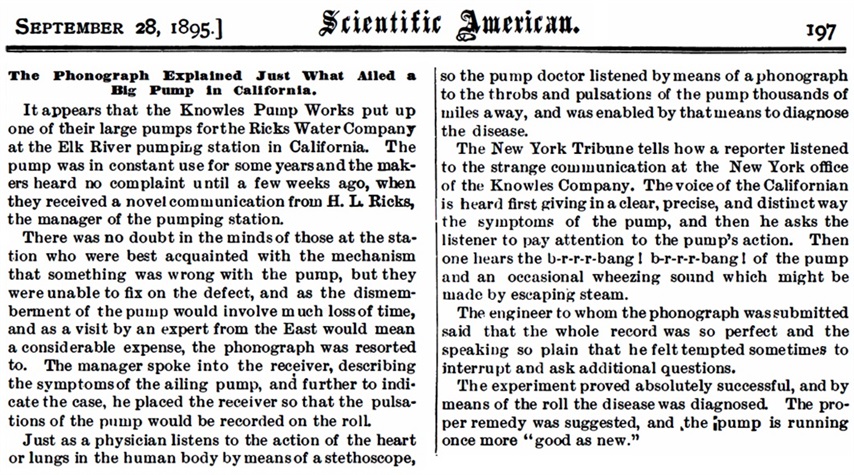
Phonograph as Witness Evidence in Courtrooms
Although there were many articles in the US media that mentioned the use of the phonograph as a legal tool around 1880s, this news was not true. It was only in the 1890s that the method was defined as “phonograph witness” or “phonograph as a witness.” Mostly the offending noise was phonographed inside homes and the intrusive sound was poultry, journalists’ typewriters, piano players, coppersmith works, and so on.
The most widely reported news about phonograph witness was an event that took place in Brussels in March 1907 when a lawyer denounced an iron foundry that was near his house because of the annoying noise. The court did not accept the complaint until he phonographed inside his library and “and set going the specially prepared cylinder. An uproar and din as from the forge of Vulcan was the result, and the ingenious lawyer won his case ‘hands down’” (Kranten 1907).
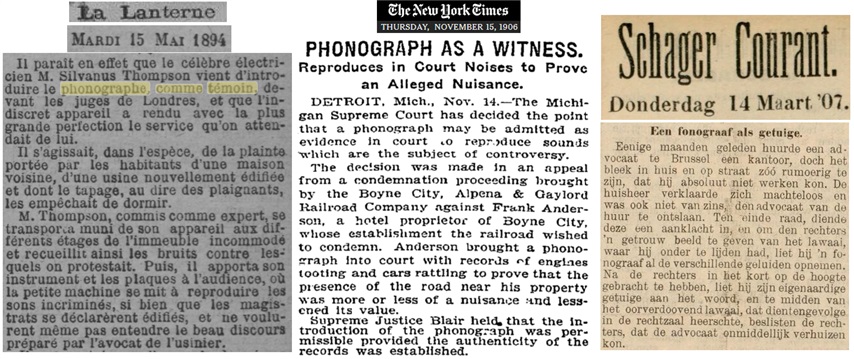
Years 1902 and 2020 Are United by Quarantines
Because of the COVID-19 pandemic, a lot of couples around the world have had to arrange their marriage as “zoom weddings,” but in 1902, a couple had to get married by means of phonograph record! There was a smallpox pandemic in Ottawa. Miss Stone (the bride) had to marry her fiancé, Duncan of Oswego, New York, but at the time of the ceremony she was infected, and the authorities forbade people to leave or enter her home: “By this time Miss Stone had fretted and worried until she was on the verge of nervous breakdown.” She was determined to get married, so she proposed to give her “Yes, I do” by phonograph.“He [the groom] hustled around and borrowed the phonograph, which was sent to the residence where the bride was a prisoner.” She sat on a chair in front of the machine and slowly spoke the words, “I, Nellie Stone, do take this man, James F. Duncan, to be my lawfully wedded husband, for better or for worse, until death do us part.” Then the cylinder was removed, fumigated, and taken to the Duncan residence “where the bridegroom and a clergyman performed their part of the ceremony” (Gippsland 1902).
Pre-1914 Sound Measurement Devices
In 1908, the option of replacing the mechanical with electrical apparatus was considered by George W. Pierce (1872–1956). He was the first person reported to think that sound could be measured “using” its electrical signals. He connected a telephone microphone to a galvanometer so he could see the variation of the intensity of the sound wave incident on the diaphragm. It worked for single tones for which the circuit had to be tuned. However, this electromechanical device was impossible to calibrate and had low sensitivity (Pierce 1908). A new device to measure the “absolute intensity of sound,” called the phonometer,[2] was improved in 1913 by Arthur Gordon Webster (1863–1923) and designed to show the direction of signal from fog horns, which meant that it could measure single tones by means of mechanical tuning (Webster 1919b).
There is an article that refers to a device developed in 1908 by Max Rubner (1854–1932), a German physiologist and hygienist at Berlin University, who “devised a kind of noise meter [lärmmesser] to determine the number of shock waves that hit our auditory organ in a unit of time” (Fortschritts 1908)—this is the only information found to date on this instrument.
Earplugs as Noise Protectors
At the beginning of the twentieth century, a wide variety of patents for earplugs were applied for, from hollow spheres made from hard rubber or metal to rubber-like hollow plugs (the “Antiphon” had been on the market since 1885, but although relatively efficient, it proved extremely impractical to use), padded headbands and spheres made from cotton wool, felt or sponge soaked in paraffin. Maximilian Negwer in 1907 sold OHROPAX noise protectors as well as other products, and later he promoted as them a functional relaxation product for everyone, turning them into a marketable product. The first pack of OHROPAX noise protectors were sold in autumn 1908 (Ohropax, n.d.).
The Beginning of theElectroacoustics Era
Since the invention of the microphone used for telephone communications, a number of scientists have tried to adapt it for sound measurements but with poor quality because of the magnetic coupling, so they had a limited frequency bandwidth. Proper electric network filter compensation was developed after the introduction of thermionic valves.
Until the invention of the thermionic valve (the diode) in 1904 by John Ambrose Fleming (1849–1945), sound levels were measured only by mechanical devices, but the beginning of the electroacoustics era was in October 1906, when Lee de Forest (1873–1961) presented the “Audion,” a thermionic two-electrode valve and, in January 1907, he added a “grid,” a “zig-zag control wire” between them, which allowed for the first time the possibility to control electrically the signal amplification. This was the first triode valve. The big advance in amplifiers with high precision was in 1913 when Edwin Howard Armstrong (1890–1954) invented the “regenerative technique” consisting of part of the triode valve output feeding back to the input (Clark 2015). Finally, de Forest developed a “cascade amplifier” improving the audio signal amplification, using up to three audions (de Forest 1914).
Acousticians had to wait for the invention of the full electronic audiometer in 1919 to start to measure sound levels. This will be discussed in the next article.
Conclusion
The author has focused on collecting data scattered in newspapers and magazines from around the world, especially those not mentioned in the general acoustic books and has decided to highlight the facts within the social and technological context like chronicles—that is, to show how ordinary people were able to imagine the problems of noise and their possible solutions.
The participants of the Ninth Otological Congress were perhaps too naive in believing that the society of the future would be more silent and that the apparatus would have a silent operation; anyway, their work and proposals were forgotten in time. The author expects that the manuscripts of that congress will be soon available for consultation to know in depth what those pioneers of the fight against unnecessary noise discussed in 1912.
The twenty-first century acousticians should not forget Blake’s proposal in 1912 of the creation of an international organization: “The establishment of such institute, especially in connection with one of our larger universities, would constitute a contribution of inestimable value to public uses,” but also “in the particular form of scientific research which has to do with the study of the production of sound, its transmission and its control.” The author believes that INCE, ICA, IIAV, ASA, and so on, live up to Blake’s desire.
Acknowledgments
The author wishes to thank Andrea Bauerdorff of Umweltbundesamt Germany for providing the rare article by Gottstein and Kayser. Special thanks to Federico Miyara of Rosario National University, Argentina, for proofreading the article; to Marion Burgess for assisting with the English expression; and to Eoin A. King and the board of the NNI magazine for publishing this second article on the history of science in acoustics.
References
Auerbach, S. 1913. “Die gesetzliche bekämpfung des vermeidbaren lärms; eine nervenhygienische forderung.” In Part I, Section VII: Hygiene of Traffic and Transportation, XV International Congress of Hygiene and Demography, 46–57. September 23–28, 1912.
Barr, T. 1886. “Enquiry into the Effects of Loud Sounds upon the Hearing of Boilermakers and Others Who Amid Noisy Surroundings.” Proceedings of the Royal Philosophical Society of Glasgow XVII:223–39. https://archive.org/details/b21457384/mode/2up.
Bell, S. 1913. “Existing Legal Provisions with Regard to the Suppression of Unnecessary Noises.” In Volume III. Part II. Section IV: Hygiene of Occupations, XV International Congress of Hygiene and Demography, September 23–28, 1912. 536–41.
Blake, C. J. 1913. “The Suppression of Unnecessary Noise.” In Volume III. Part II. Section IV: Hygiene of Occupations, XV International Congress of Hygiene and Demography, September 23–28, 1912. 533–36.
Carpe Librum. n.d. Clarence John Blake and the Bell Telephone: An Archive. Accessed March 9, 2020. https://www.carpelibrumbooks.com/clarence-john-blake-archive.
Clark, K. 2015. “The History of Audio and Sound Measurement.” Acoustics, Audio Technology.
de Forest, L. 1914. “The Audion-Detector and Amplifier.” Proceedings of the Institute of Radio Engineers 2 (1). https://worldradiohistory.com/Archive-IRE/10s/IRE-1914-03.pdf.
Duchesne, E.-A. 1857. Des chemins de fer et de leur influence sur la santé des mécaniciens et des chauffeurs. Paris: Mallet-Bachelier.
Engineering Magazine. 1896. “The Plague of City Noises.” Vol. 12, no. 1 (October): 192.
Fortschritts, D. 1908. “Lärmmesser.” Dokumente des Fortschritts, 392.
Fosbroke, J. 1831. “Practical Observations on the Pathology and Treatment of Deafness. (a) No. I, pp. 535–537. (b) No. II, pp. 645–648. (c) No. III, pp. 740–743.” The Lancet MDCCCXXX–XXXI I (September). https://ia800606.us.archive.org/26/items/B-001-003-438/The_Lancet_London.pdf.
Gippsland. 1902. “Married by Phonograph.” West Gippsland Gazette. October 7, 1902, 6. https://trove.nla.gov.au/newspaper/article/68721380.
Girdner, J. H. 1896. “The Plague of City Noises.” The North American Review 163, no. 478 (September): 296–303.
———. 1897. “To Abate the Plague of City Noises.” The North American Review 165, no. 491 (October): 460–68.
———. “Noise and Health.” Munsey’s Magazine, June 1901, 323–25.
Gottstein, J., and R. Kayser 1881. “Ueber die Gehörsverminderung bei Schlossern und Schmieden.” Breslauer Aerztliche Zeitschrift 3: .
Kranten. 1907. “Ein fonograaf als getuige.” Kranten Regionaal Archief Alkmaar Schager Courant, 6. https://kranten.archiefalkmaar.nl/issue/SC/1907-03-14/edition/null/page/6?query=.
Layet, A. 1875. Hygiène des professions et des industries. Paris: J.-B. Baillière et Fils.
Montano, W. 2020. “The First International Anti-noise Conventions/Congresses: 1895–1912.” Noise/News International Magazine. http://noisenewsinternational.net/the-first-international-anti-noise-conventions-congresses-1895-1912/.
Morse, E. S. 1905. “Abstract of Prof. Morse’s Paper on ‘Noise.’” American Journal of Public Hygiene and Journal of the Massachusetts Association of Boards of Health XV, no. I (February): 299 (n.s. Vol. 1., no. 2).
Ohropax. n.d. “The Story of Our Story.” Accessed March 9, 2020. https://www.ohropax.de/en/about-ohropax/history.
Pierce, G. W. 1908. “A Simple Method of Measuring the Intensity of Sound.” Proceedings of the American Academy of Arts and Sciences 43, no. 13 (February): 377–95.
Ramazzini, B. 1713. Diseases of Workers. Translated from the Latin text De morbis artificum of 1713 by Wilmer Cave Wright, with an introduction by George Rosen. New York: Hafner Publishing, 1964 (reprint).
Roosa, D. B. St J. 1873. Practical Treatise on the Diseases of the Ear, Including the Anatomy of the Organ. New York: William Wood.
Schafer, E. A. 1912, September 14. “An Address on the Nature, Origin, and Maintenance of Life.” The British Medical Journal. http://europepmc.org/backend/ptpmcrender.fcgi?accid=PMC2334297&blobtype=pdf.
Scientific American. 1895. “The Phonograph Explained Just What Ailed a Big Pump in California.” September 28, 1895, 197.
Siebenmann, F. 1912. “Demonstration mikroskopischer und makroskopischer Preparate von Otospogiosiss progressiva.” Proceedings of International Otological Congress, 207.
SIOeChCF. n.d. “La Storia.” Società Italiana di Otorinolaringoiatria e Chirurgia Cervico Facciale. Accessed March 9, 2020. http://www.sioechcf.it/la-storia/.
The Times. 1875. “The Phonometer.” July 5, 1875, 8.
Turkington, C., and Sussman, A. E. (1992). The Encyclopedia of Deafness and Hearing Disorders. New York: Facts on File.
Webster, A. G. 1919a. “Acoustical Impedance and the Theory of Horns and of the Phonograph.” PNAS 5, no. 7 (July): 275–82. https://doi.org/10.1073/pnas.5.7.275.
———. 1919b. “A Complete Apparatus for Absolute Acoustical Measurements.” PNAS 5, no. 5 (May 1): 173–79. https://doi.org/10.1073/pnas.5.5.173.
Notes
[1]. C was set to 256 Hz (C4 note), also named “Scientific pitch” (or “Philosophical pitch”). It was first proposed in 1713 by French physicist Joseph Sauveur, who also coined the word acoustique to identify the study of waves as an independent branch of science, in 1701.
[2]. The first phonometer device was developed in 1875 in England (The Times, 1875).


